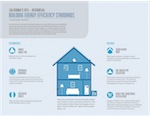Electromagnetic Interference (EMI, aka: “Dirty Electricity,” or “High Voltage Transients”) is a term coined for quick transient pulses, harmonics, spikes and dips in the electrical power in a home’s wiring that deviates from a purely 60Hz sine wave. These often occur due to computers, other electronics, mini transformers/power convertors, dimmer switches, CFL and LED lighting. Purely resistive loads such as incandescent lighting, electric heating elements and the like, do not contribute to dirty electricity as they do not alter the frequency of the power incoming for their purposes. Here we explore EMI and LEDs.
In the act of altering the frequency for their purpose, electronic devices ‘backfeed’ small amounts of electricity back onto the incoming power line, disrupting it. This can be imagined like a pond with a continuous smooth ripple where other disturbances compound and disrupt that ripple making it ‘choppy’. You can read more about this phenomenon at Gust Environmental and the US National Library of Medicine and National Institutes of Health. There are many other websites that also support and attempt to discount this phenomenon.
It is known that these deviant voltages can wear on and damage other electronic devices, however it has also been shown that the human electric field also becomes induced with these deviant voltages. While these bodily voltage changes are ubiquitous and happen to everyone, not everyone is sensitive to them or have symptoms related to them.
A Nascent Field
There are several companies on the market that produce dirty electricity filters and meters to attenuate these deviant transient voltages on the power line. The forerunner of these filters and meters is Stetzer Electric Inc. and their leading competitor is Greenwave. Both companies appear to produce dirty electricity filters that perform admirably when measured by their competitor’s own dirty electric meters. Unfortunately, the two companies seem to lash out at each other rather than collaborate in this nascent field. In a later blog we may perform additional research to determine which brand’s filter performs better for various dirty electrical issues.
However, why should you even need to buy filters to remove the dirty electricity? Not all electronic devices are made the same. If you can make an educated choice and choose devices that produce less dirty electricity, the need for filters decreases. Your individual need for filters might not reach zero, but you may be able to go with less filters than what Stetzer Electric Inc. or Greenwave recommends.
It has often been said in the dirty electricity circles that LED lighting produces less dirty electricity than CFL lighting. CFL lighting produces dirty electricity due to the fact that CFLs operate at high frequencies (typically between 10kHz to 40kHz) and need electronics to control the voltages and frequencies to make it operate. LEDs, it is commonly thought, produce less dirty electricity since LEDs use DC current and the electronics needed to convert the 60Hz down to DC current is less complicated. However as this study shows, less complicated does not always mean less ‘dirty’.
Dirty Electricity (EMI) Measurements
Using a Stetzer meter and a Greenwave EMI meter, the various dirty electric values of several CFL and LED manufacturers were measured. Both meters were used since the methods of their quantification of dirty electricity are different. These CFLs and LEDs were all chosen with the luminosity of near 800 lumens (the equivalent of a 60W incandescent bulb). An incandescent bulb measurement was included in each of the graphs to give a baseline for comparison purposes.
Using the Greenwave EMI meter, in regards to CFLs: GE and Philips measured better than Ecosmart, though they did produce 2-1/2 times more dirty electricity than what was present on the power line already (baseline is the GE Incandescent). GE CFLs performed slightly better than the Philips brand as measured by the Greenwave EMI meter.
Using the Stetzer meter, in regards to CFLs: GE and Philips again measured better than Ecosmart, though they did produce 10 times more dirty electricity than what was present on the power line already (baseline is the GE Incandescent). Philips CFLs performed slightly better than the GE brand as measured by the Stetzer meter.
Using the Greenwave EMI meter, in regards to LEDs: Ecosmart and CREE measured much better than Philips, though Ecosmart still produced more than twice the dirty electricity than what was present on the power line already (baseline is the GE Incandescent), the CREE LEDs only produced roughly 15% more dirty electricity compared to the baseline. Philips LEDs produced more than 3 times the dirty electricity as compared to the Philips and GE CFLs on the previous page. CREE LEDs performed extremely well as measured by the Greenwave EMI meter.
Cameron Das is an environmental inspector at Healthy Building Science, a firm offering healthy building inspections and green building consulting services from the San Francisco Bay Area. This post originally appeared at their website and is re-printed here by permission of Healthy Building Science.








